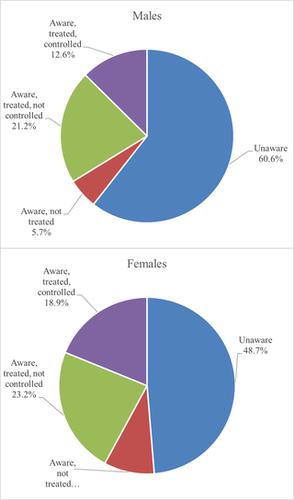PLOS ONE ( IF 2.9 ) Pub Date : 2018-09-20 , DOI: 10.1371/journal.pone.0204344 Leslie S. Craig , Anastasia J. Gage , Albertina M. Thomas

|
Background
Hypertension has been identified as the single greatest contributor to the global burden of disease and mortality, with estimates suggesting that the highest levels of blood pressure have shifted from high-income countries to low-income countries in sub-Saharan Africa. While evidence suggests a remarkably high prevalence of hypertension among urban residents in Namibia, national estimates to inform on the country-level burden are lacking. This study estimates the prevalence and predictors of hypertension among Namibian adults.
Methods
The analysis is based on 1,795 women and 1,273 men aged 35–64 years from the nationally-representative 2013 Namibia Demographic and Health Survey. Odds radios and 95% confidence intervals were estimated using logistic regression.
Results
The age-standardized prevalence of hypertension was 46.0% (men vs. women: 46.1% vs. 46.0%). Mean systolic and diastolic blood pressures for the total population were 128.8 mmHg (95% CI 127.8–129.7) and 83.1 mmHg (95% CI 82.5–83.7), respectively. Mean systolic blood pressure was significantly lower among women (men vs. women: 130.9 mmHg vs. 127.4 mmHg; p<0.001). There were no statistically significant differences in mean diastolic blood pressure between men and women. Older age, urban residence, and being either overweight or obese were positively associated with the odds of hypertension (p<0.01). For women, the odds of hypertension were also significantly increased for those who were diabetic (i.e. had a fasting blood glucose level greater than 7.0 mmol/L) and reduced for those with higher levels of education.
Conclusion
The prevalence of hypertension among Namibian adults is high and associated with metabolic and socio-demographic factors. Future research examining disease comorbidity and behavioral risk factors could better inform on the disease burden and help target resources to optimize prevention and control.
中文翻译:

纳米比亚高血压的患病率和预测因素:一项国家水平的横断面研究
背景
高血压已被确定为造成全球疾病和死亡率负担的最大原因,据估计,高血压的最高水平已从撒哈拉以南非洲的高收入国家转移到了低收入国家。尽管有证据表明纳米比亚城市居民中高血压的患病率非常高,但仍缺乏用于说明国家一级负担的全国性估算。这项研究估计了纳米比亚成年人中高血压的患病率和预测因素。
方法
该分析基于全国代表性的2013年纳米比亚人口与健康调查的1795名女性和1273名男性,年龄在35-64岁之间。使用逻辑回归估计赔率和95%置信区间。
结果
年龄标准化的高血压患病率为46.0%(男性对女性:46.1%对46.0%)。总人群的平均收缩压和舒张压分别为128.8 mmHg(95%CI 127.8-129.7)和83.1 mmHg(95%CI 82.5-83.7)。女性的平均收缩压显着降低(男性与女性:130.9 mmHg与127.4 mmHg;p <0.001)。男女平均舒张压之间无统计学差异。老年人,城市居民,超重或肥胖与高血压几率呈正相关(p <0.01)。对于女性而言,糖尿病患者(即空腹血糖水平高于7.0 mmol / L)的高血压几率也显着增加,而受教育程度较高的患者则降低了高血压的几率。
结论
纳米比亚成年人中高血压的患病率很高,并且与代谢和社会人口统计学因素有关。未来研究疾病合并症和行为危险因素的研究可以更好地告知疾病负担,并帮助目标资源优化预防和控制。











































 京公网安备 11010802027423号
京公网安备 11010802027423号